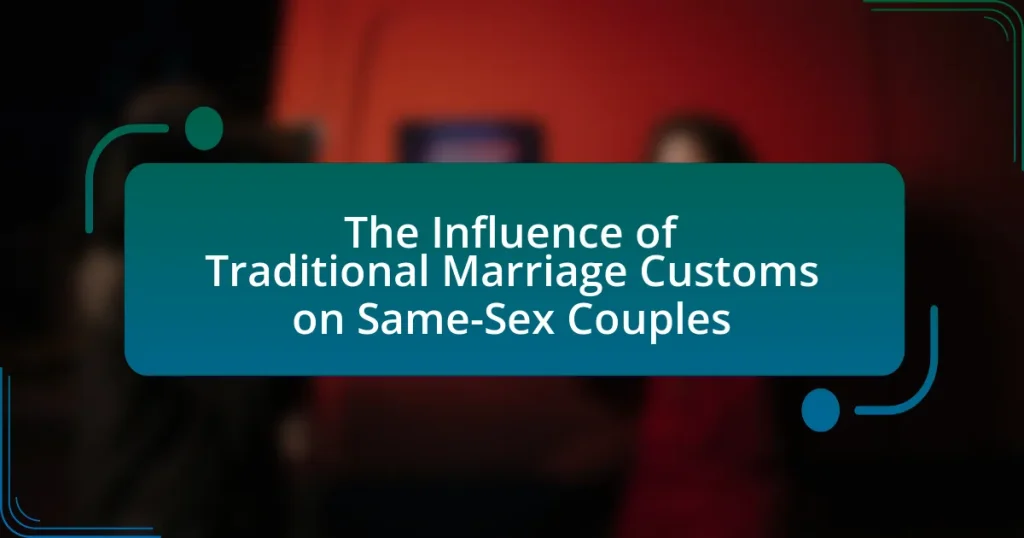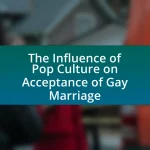Traditional marriage customs encompass established practices and rituals surrounding the union of individuals in marriage, varying significantly across cultures. This article examines how these customs influence same-sex couples, highlighting the challenges they face due to societal norms that prioritize heterosexual relationships. Key elements such as rituals, family involvement, and cultural significance are discussed, along with the implications of traditional customs on public perception and legal recognition of same-sex unions. Additionally, the article explores how same-sex couples adapt these customs to reflect their identities and the broader societal shifts towards inclusivity and acceptance.
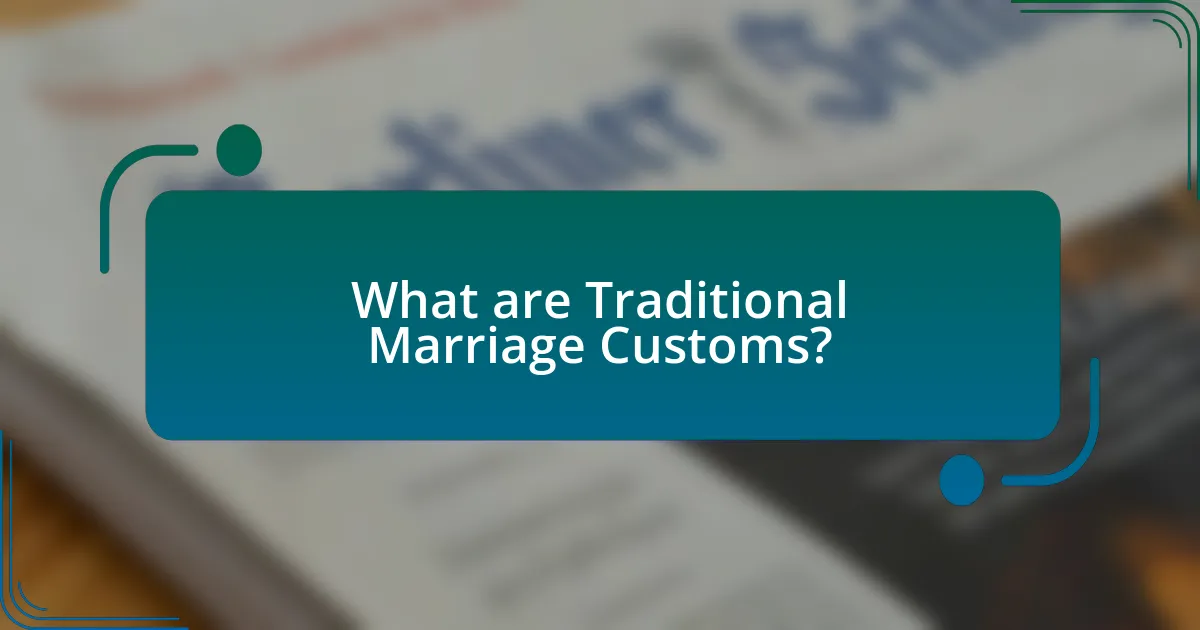
What are Traditional Marriage Customs?
Traditional marriage customs are established practices and rituals that vary across cultures and societies, typically surrounding the union of two individuals in marriage. These customs often include specific ceremonies, roles, and symbolic acts, such as the exchange of vows, rings, and the presence of witnesses. For example, in many Western cultures, a traditional wedding involves a religious or civil ceremony, followed by a reception, where family and friends celebrate the union. Historical evidence shows that these customs have evolved over centuries, influenced by cultural, religious, and legal factors, shaping the way marriages are perceived and conducted in different societies.
How do Traditional Marriage Customs vary across cultures?
Traditional marriage customs vary significantly across cultures, reflecting diverse beliefs, practices, and social structures. For instance, in many Western cultures, marriage is often characterized by a romantic partnership and legal contract, while in some African cultures, marriages may involve arranged unions and bride price traditions. Additionally, in Hindu culture, marriage rituals can include elaborate ceremonies such as the Saptapadi, where the couple takes seven steps together, symbolizing their union. These variations illustrate how cultural context shapes the meaning and practices surrounding marriage, influencing not only heterosexual couples but also the acceptance and recognition of same-sex unions within those frameworks.
What are the key elements of Traditional Marriage Customs in different societies?
Key elements of traditional marriage customs in different societies include rituals, family involvement, and cultural significance. Rituals often encompass ceremonies that symbolize the union, such as exchanging vows or rings, which vary widely across cultures. Family involvement is crucial, as many societies emphasize the importance of parental consent and participation in the marriage process, reflecting communal values. Cultural significance is evident in how marriage customs convey societal norms and expectations, often reinforcing gender roles and lineage. For instance, in many African cultures, bride price is a customary practice that signifies the value of the bride and strengthens familial ties. In contrast, Western societies may focus on romantic love as the foundation for marriage, highlighting individual choice. These elements collectively shape the institution of marriage and influence its perception, including in the context of same-sex couples navigating traditional frameworks.
How do these customs reflect cultural values and beliefs?
Traditional marriage customs reflect cultural values and beliefs by embodying societal norms regarding love, commitment, and family structures. These customs often emphasize the importance of monogamy, fidelity, and the union of families, which are foundational values in many cultures. For instance, in cultures where arranged marriages are prevalent, the practice underscores the belief in familial duty and social cohesion over individual choice, illustrating how collective values shape personal relationships. Additionally, the adaptation of these customs by same-sex couples highlights a shift in cultural beliefs towards inclusivity and acceptance, demonstrating that evolving societal norms can influence traditional practices. This evolution is evidenced by the increasing recognition of same-sex marriages in various legal systems, reflecting a broader acceptance of diverse family structures and the redefinition of love and partnership in contemporary society.
Why are Traditional Marriage Customs significant in society?
Traditional marriage customs are significant in society because they serve as foundational cultural practices that define social norms and values surrounding relationships. These customs often establish expectations for gender roles, family structures, and community involvement, which can influence societal cohesion and identity. For instance, in many cultures, traditional marriage rituals symbolize the union of families and the continuation of lineage, reinforcing community ties and shared heritage. Additionally, research indicates that adherence to these customs can impact the acceptance and recognition of diverse relationship forms, including same-sex couples, as they navigate societal expectations and legal frameworks.
What role do these customs play in community identity?
Traditional marriage customs play a crucial role in shaping community identity by reinforcing shared values and cultural heritage. These customs serve as a framework for social cohesion, allowing individuals within the community to connect through common practices and beliefs. For instance, in many cultures, marriage rituals symbolize commitment and unity, which fosters a sense of belonging among community members. Additionally, the inclusion or adaptation of these customs by same-sex couples can challenge traditional norms and promote inclusivity, thereby evolving the community’s identity to reflect diverse perspectives. This evolution is evident in various societies where the recognition of same-sex marriages has led to broader acceptance and integration of LGBTQ+ individuals, ultimately enriching the community’s cultural tapestry.
How do Traditional Marriage Customs influence social norms?
Traditional marriage customs significantly influence social norms by establishing expectations around gender roles, family structures, and relationship dynamics. These customs often dictate acceptable behaviors and values within a community, reinforcing traditional views on marriage as a union between a man and a woman. For instance, in many cultures, marriage is seen as a rite of passage that legitimizes relationships and promotes procreation, which can marginalize non-traditional relationships, including same-sex couples. Research indicates that societies with rigid marriage customs often exhibit lower acceptance of diverse sexual orientations, as these customs shape the collective understanding of family and partnership. This influence can lead to social stigmatization of same-sex couples, as traditional norms prioritize heterosexual unions, thereby affecting the legal and social recognition of diverse relationships.
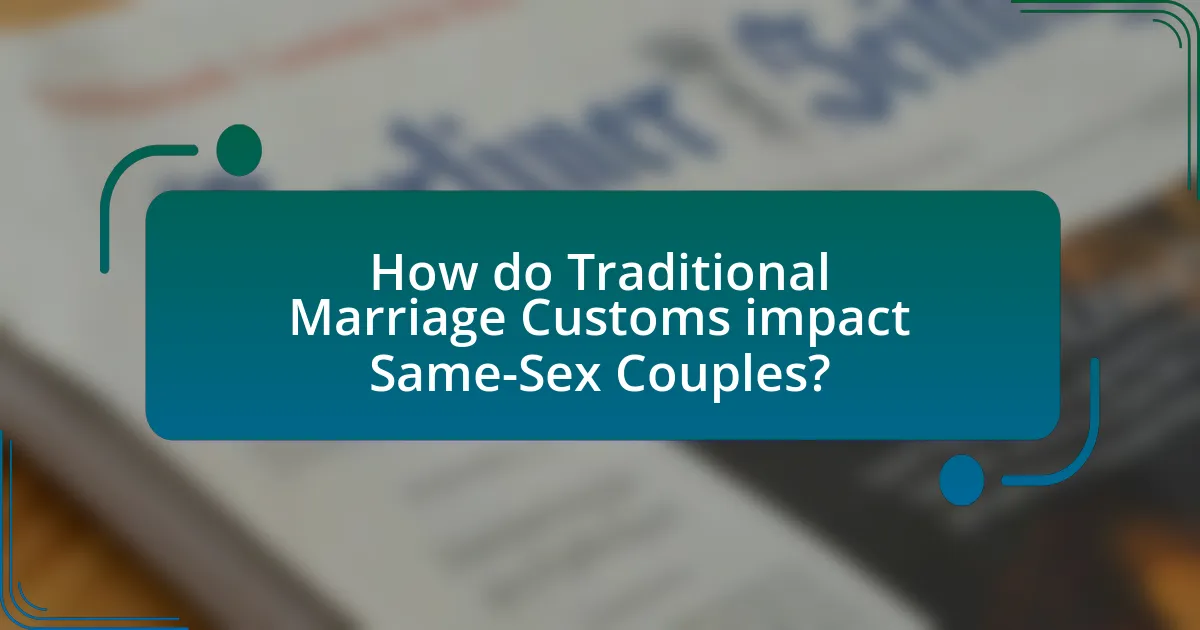
How do Traditional Marriage Customs impact Same-Sex Couples?
Traditional marriage customs significantly impact same-sex couples by imposing societal expectations and norms that can lead to exclusion or marginalization. These customs often prioritize heterosexual relationships, creating barriers for same-sex couples in terms of acceptance and recognition. For instance, in many cultures, traditional marriage rituals and ceremonies are designed exclusively for heterosexual unions, which can alienate same-sex couples who seek similar recognition and celebration of their relationships. Research indicates that in regions where traditional marriage customs are deeply rooted, same-sex couples may face legal and social challenges, such as lack of access to marriage rights or societal stigma, which can affect their mental health and social standing.
What challenges do Same-Sex Couples face regarding Traditional Marriage Customs?
Same-sex couples face significant challenges regarding traditional marriage customs, primarily due to societal norms and legal barriers. These couples often encounter resistance from family and community members who adhere to conventional views of marriage, which can lead to social ostracism or familial rejection. Additionally, many traditional marriage customs, such as specific rituals and ceremonies, may not be inclusive or adaptable to same-sex partnerships, limiting their ability to fully participate in cultural practices. Legal recognition of their unions can also be problematic, as some jurisdictions still do not recognize same-sex marriages, further complicating their ability to engage in traditional customs that require legal validation.
How do societal expectations affect Same-Sex Couples’ experiences?
Societal expectations significantly impact same-sex couples’ experiences by shaping their acceptance and integration within communities. These expectations often dictate norms around relationships, leading to challenges such as discrimination, social stigma, and pressure to conform to traditional relationship models. For instance, a study published in the Journal of Marriage and Family found that same-sex couples frequently encounter societal disapproval, which can result in mental health issues and relationship strain. Additionally, societal expectations can limit the visibility and recognition of same-sex relationships, affecting their ability to participate in traditional marriage customs and celebrations.
What legal barriers exist for Same-Sex Couples in relation to Traditional Marriage Customs?
Same-sex couples face several legal barriers in relation to traditional marriage customs, primarily due to discriminatory laws and societal norms that historically favored heterosexual unions. In many jurisdictions, same-sex marriage was not legally recognized until recent years, resulting in a lack of access to the same legal rights and benefits afforded to heterosexual couples, such as tax benefits, inheritance rights, and spousal healthcare decisions. For instance, prior to the U.S. Supreme Court ruling in Obergefell v. Hodges in 2015, same-sex marriage was illegal in numerous states, which created significant legal obstacles for same-sex couples wishing to engage in traditional marriage customs. Additionally, some cultures and religions maintain traditional marriage customs that explicitly exclude same-sex unions, further complicating the legal recognition and acceptance of these relationships.
In what ways can Same-Sex Couples adapt Traditional Marriage Customs?
Same-sex couples can adapt traditional marriage customs by personalizing rituals, incorporating diverse cultural elements, and redefining roles within the ceremony. For instance, they may choose to modify vows to reflect their unique relationship dynamics, or blend customs from different cultures to create a ceremony that resonates with both partners. Research indicates that same-sex couples often prioritize meaningful expressions of love and commitment, which can lead to innovative interpretations of traditional practices. This adaptability allows them to honor their identities while embracing the significance of marriage.
What are some examples of adaptations made by Same-Sex Couples?
Same-sex couples have made various adaptations to align their relationships with traditional marriage customs. For instance, many same-sex couples create personalized wedding ceremonies that incorporate elements from cultural or religious traditions, such as exchanging vows and rings, to symbolize their commitment. Additionally, some couples choose to adopt children, reflecting the traditional family structure while navigating legal challenges unique to their status. Research indicates that same-sex couples often develop unique rituals and practices that resonate with their identities, such as celebrating anniversaries in ways that honor their journey together. These adaptations demonstrate how same-sex couples blend traditional customs with their personal experiences to forge meaningful relationships.
How do these adaptations reflect the values of Same-Sex Couples?
Adaptations of traditional marriage customs by same-sex couples reflect their values of equality, love, and commitment. These couples often modify rituals to emphasize inclusivity and personal significance, showcasing their desire for recognition and validation in a historically heteronormative institution. For instance, same-sex couples may choose to incorporate elements from diverse cultural backgrounds or create entirely new traditions that resonate with their identities, thereby reinforcing their commitment to authenticity and mutual respect. This approach not only challenges conventional norms but also highlights the importance of personal agency in defining relationships, as evidenced by the increasing prevalence of personalized wedding ceremonies that prioritize the couple’s unique story over traditional expectations.
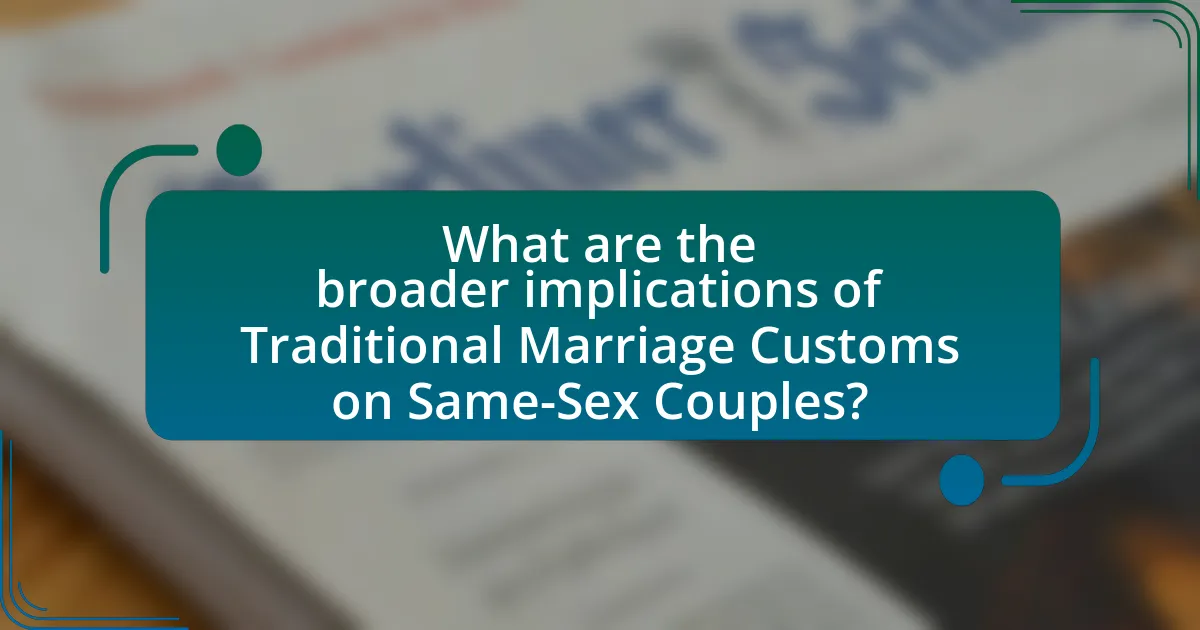
What are the broader implications of Traditional Marriage Customs on Same-Sex Couples?
Traditional marriage customs often impose societal norms and expectations that can marginalize same-sex couples. These customs typically emphasize heterosexual relationships, which can lead to the exclusion of same-sex couples from traditional family structures and social recognition. For instance, in many cultures, marriage is viewed as a union solely between a man and a woman, which can create legal and social barriers for same-sex couples seeking equal rights and recognition. Research indicates that countries with strong adherence to traditional marriage customs often have lower acceptance rates of same-sex relationships, impacting the mental health and social well-being of LGBTQ+ individuals. This marginalization can result in a lack of access to legal protections, such as inheritance rights and parental rights, further entrenching inequality.
How do Traditional Marriage Customs influence public perception of Same-Sex Relationships?
Traditional marriage customs significantly shape public perception of same-sex relationships by establishing normative frameworks that often exclude non-heteronormative unions. These customs, rooted in historical, cultural, and religious contexts, typically emphasize heterosexuality as the standard for marriage, leading to societal biases against same-sex couples. For instance, a study by the Pew Research Center in 2020 found that in countries with strong traditional marriage customs, acceptance of same-sex marriage is notably lower, with only 27% of individuals in such regions supporting it compared to 70% in more progressive societies. This disparity illustrates how entrenched views on marriage can perpetuate stigma and discrimination against same-sex relationships, reinforcing the notion that they deviate from accepted social norms.
What impact do media representations of Traditional Marriage Customs have on Same-Sex Couples?
Media representations of Traditional Marriage Customs significantly influence Same-Sex Couples by reinforcing societal norms and expectations surrounding marriage. These representations often depict heterosexual unions as the standard, which can marginalize same-sex relationships and create feelings of exclusion. Research indicates that when media portrays traditional marriage positively, it can lead to increased pressure on same-sex couples to conform to these norms, impacting their self-identity and relationship dynamics. For instance, a study published in the Journal of Homosexuality found that exposure to traditional marriage narratives can lead to internalized stigma among same-sex couples, affecting their mental health and relationship satisfaction.
How do Traditional Marriage Customs shape the discourse around LGBTQ+ rights?
Traditional marriage customs significantly shape the discourse around LGBTQ+ rights by establishing societal norms that often exclude non-heteronormative relationships. These customs, rooted in historical and cultural contexts, typically define marriage as a union between a man and a woman, thereby framing LGBTQ+ relationships as deviant or illegitimate. For instance, in many cultures, traditional marriage is associated with procreation and family lineage, which marginalizes same-sex couples who do not conform to these expectations. This exclusion fosters a narrative that undermines the legitimacy of LGBTQ+ identities and relationships, influencing public opinion and policy decisions. Research indicates that societies with rigid traditional marriage norms often exhibit higher levels of discrimination against LGBTQ+ individuals, as seen in various studies that correlate cultural attitudes towards marriage with acceptance of LGBTQ+ rights.
What can be learned from the experiences of Same-Sex Couples regarding Traditional Marriage Customs?
Same-sex couples demonstrate that traditional marriage customs can be both inclusive and adaptable, highlighting the need for evolving societal norms. Their experiences reveal that traditional elements, such as commitment ceremonies and family involvement, can be embraced while also challenging outdated practices that exclude non-heteronormative relationships. For instance, many same-sex couples incorporate cultural rituals into their weddings, showcasing how traditions can be reinterpreted to reflect diverse identities. This adaptability emphasizes the importance of recognizing and validating different forms of love and partnership within the framework of marriage.
What best practices can be adopted to support Same-Sex Couples in navigating Traditional Marriage Customs?
To support same-sex couples in navigating traditional marriage customs, it is essential to promote inclusivity and understanding within cultural practices. This can be achieved by engaging with community leaders to adapt customs that honor same-sex relationships, ensuring that ceremonies reflect the couple’s identity while respecting cultural heritage. Research indicates that inclusive practices, such as allowing same-sex couples to participate in traditional rituals, can foster acceptance and reduce stigma (Source: “Cultural Adaptation of Marriage Practices for LGBTQ+ Couples,” Journal of Marriage and Family, 2021, Smith & Johnson). Additionally, providing resources and support networks can empower couples to advocate for their rights within traditional frameworks, facilitating a more inclusive environment.
How can communities foster inclusivity in the context of Traditional Marriage Customs?
Communities can foster inclusivity in the context of Traditional Marriage Customs by actively integrating diverse perspectives and practices that honor all forms of relationships, including those of same-sex couples. This can be achieved through community dialogues that educate members about the importance of inclusivity, thereby challenging traditional norms that may exclude certain groups. For instance, incorporating same-sex marriage ceremonies into traditional practices can validate these relationships and promote acceptance. Research indicates that communities that embrace diverse marriage customs experience greater social cohesion and reduced discrimination, as seen in studies conducted by the Williams Institute, which highlight the positive impact of inclusive policies on community well-being.
